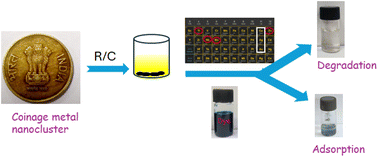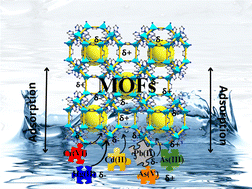
RSC Advances
Subject area
Toxicity articles published in the last
6 months

Adsorptive removal of norfloxacin from aqueous solutions by Fe/Cu CNS-embedded alginate–carboxymethyl cellulose–chitosan beads
Schematic representation of NOR adsorption mechanisms by the NBs.

RSC Adv., 2024,14, 15862-15875
https://doi.org/10.1039/D4RA01971G
Phosphorus adsorption from aqueous solutions using different types of cement: kinetics, isotherms, and mechanisms
This study reveals the potential of cement as a cost-effective and high-capacity adsorbent for removing phosphorus from acidic and neutral wastewaters.

RSC Adv., 2024,14, 15637-15646
https://doi.org/10.1039/D4RA01929F
Electrocatalytic water treatment of per- and polyfluoroalkyl substances reduces adsorbable organofluorine and bioaccumulation potential
Per- and polyfluoroalkyl substances (PFAS) are pervasive in industrial processes, eliciting public concern upon their release into municipal sewers or the environment.

RSC Adv., 2024,14, 15627-15636
https://doi.org/10.1039/D4RA02448F
Investigation of the photocatalytic activity of magnetically recoverable g-C3N4/CoFe2O4/Bi2MoO6 particles for purifying tetracycline antibiotics: synthesis, characterization, ecotoxicity analysis, and plant toxicity test
To purify water polluted by tetracycline antibiotics, a new visible light-driven magnetically recoverable photocatalyst, g-C3N4/CoFe2O4/Bi2MoO6, was prepared in this study, and it effectively removed tetracycline antibiotics.

RSC Adv., 2024,14, 15302-15318
https://doi.org/10.1039/D4RA01593B
Achievement of waste sludge deep dehydration under acidic conditions with polydimethyldiallylammonium chloride and ferric chloride: performance and mechanism
The biological treatment of wastewater generates a substantial amount of waste sludge that requires dewatering before final disposal.

RSC Adv., 2024,14, 15031-15038
https://doi.org/10.1039/D4RA01311E
Advanced photocatalytic materials based degradation of micropollutants and their use in hydrogen production – a review
The future directions of photocatalytic degradation of micropollutants (pharmaceuticals, dyes, pesticides, etc.) and its role in green fuel production from wastewater are discussed with several examples of modern photocatalysts.

RSC Adv., 2024,14, 14392-14424
https://doi.org/10.1039/D4RA01307G
Unleashing the promise of emerging nanomaterials as a sustainable platform to mitigate antimicrobial resistance
The emergence and spread of antibiotic-resistant (AR) bacterial strains and biofilm-associated diseases have heightened concerns about exploring alternative bactericidal methods.

RSC Adv., 2024,14, 13862-13899
https://doi.org/10.1039/D3RA05816F
Enhanced thermal desorption of chlorinated hydrocarbons by nanoscale zero-valent iron: the effect of in situ dechlorination
The thermal desorption of CHs in contaminated soil was enhanced by the in situ dechlorination effect brought by the addition of nZVI.

RSC Adv., 2024,14, 14254-14262
https://doi.org/10.1039/D4RA01077A
Mechanistic explanation and influence of molecular structure on chemical degradation and toxicity reduction by hydroxyl radicals
The study elucidated environmental toxicity impact along with mechanistic degradation of organic emerging contaminants with different aromaticity and aliphaticity.

RSC Adv., 2024,14, 13926-13933
https://doi.org/10.1039/D4RA00827H
Degradation of fluoride in groundwater by electrochemical fixed bed system with bauxite: performance and synergistic catalytic mechanism
This study demonstrates that the coordinated defluorination system (IE-BA) which is made up of the industrial aluminum electrode and natural bauxite for fluoride removal. The defluorination mechanism of the IE-BA system is discussed.

RSC Adv., 2024,14, 13711-13718
https://doi.org/10.1039/D4RA01359J
Application of cold-adapted microbial agents in soil contaminate remediation: biodegradation mechanisms, case studies, and safety assessments
Analyzed the microorganisms cold-adapted mechanism, and summarized the degradation pathway of nitro-aromatic compounds. Evaluated safety of microbial agents according to the existing application restoration cases under freeze-thaw cycles condition.

RSC Adv., 2024,14, 12720-12734
https://doi.org/10.1039/D4RA01510J
Resistance and durability of fly ash based geopolymer for heavy metal immobilization: properties and mechanism
This study employed geopolymerization technique to solidify MSWI fly ash, aiming to facilitate its reutilization. The FA based geopolymers exhibit strong durability and mechanical qualities, making them suitable for a variety of applications.

RSC Adv., 2024,14, 12580-12592
https://doi.org/10.1039/D4RA00617H
Reusable magnetic mixture of CuFe2O4–Fe2O3 and TiO2 for photocatalytic degradation of pesticides in water
Mixture of TiO2-P25 and magnetic CuFe2O4–Fe2O3 nanocomposites improves photocatalytic water treatment and enables easy catalyst recovery, effectively degrading pollutants like 2,4-D.

RSC Adv., 2024,14, 12337-12348
https://doi.org/10.1039/D4RA00094C
Freezing-enhanced chlorination of organic pollutants for water treatment
Freezing-accelerated chlorination was observed for different organic pollutants and the chlorine/freezing system shows potential feasibility for water treatment in cold environments.

RSC Adv., 2024,14, 12218-12224
https://doi.org/10.1039/D4RA00081A
Novel ultrasonic technology for advanced oxidation processes of water treatment
Textile wastewater accounts for a significant proportion of industrial wastewater worldwide.

RSC Adv., 2024,14, 11939-11948
https://doi.org/10.1039/D4RA01665C
Corals-inspired magnetic absorbents for fast and efficient removal of microplastics in various water sources
Mesoporous Fe3O4 nanoparticles were coated with polymerized dopamine to mimic corals for adsorption of microplastics from different water sources.

RSC Adv., 2024,14, 11908-11913
https://doi.org/10.1039/D4RA02521K
Removal of Cr(VI) in wastewater by Fe–Mn oxide loaded sludge biochar
Sludge biochar loaded with Fe–Mn oxides (FMBC) was prepared and employed to remove Cr(VI) from wastewater.

RSC Adv., 2024,14, 11746-11757
https://doi.org/10.1039/D4RA00169A
Comprehensive assessment of carbon-, biomaterial- and inorganic-based adsorbents for the removal of the most hazardous heavy metal ions from wastewater
This article is about recoverable adsorbents for the removal of metal-based water contaminants. It presents the role of the homogeneity and heterogeneity of adsorbents, kinetics of adsorption, and the mechanism of the sorption process.

RSC Adv., 2024,14, 11284-11310
https://doi.org/10.1039/D4RA00976B
Role of transition metals in coinage metal nanoclusters for the remediation of toxic dyes in aqueous systems
Coinage metal nanoclusters are doped with transition metals to obtain an efficient photocatalyst and adsorbent for the removal of toxic dyes.

RSC Adv., 2024,14, 11411-11428
https://doi.org/10.1039/D4RA00931B
Cyanoremediation of heavy metals (As(V), Cd(II), Cr(VI), Pb(II)) by live cyanobacteria (Anabaena variabilis, and Synechocystis sp.): an eco-sustainable technology
Cyanoremediation of heavy metals by surface adsorption of live cyanobacteria represents a promising technique for wastewater treatment.

RSC Adv., 2024,14, 10452-10463
https://doi.org/10.1039/D4RA00409D
Heterocycle compounds synthesized by amide ligand-promoted copper salt catalyzed construction of C–O(S) bonds
We introduce a mild method for the ligand-promoted copper-catalyzed coupling of 2-halophenol to construct DBDO using cost-effective copper salts, ligands, and alkaline reagents.

RSC Adv., 2024,14, 10034-10038
https://doi.org/10.1039/D4RA00701H
Recent advances in microbial and enzymatic engineering for the biodegradation of micro- and nanoplastics
This review examines the escalating issue of plastic pollution, specifically highlighting the detrimental effects on the environment and human health caused by microplastics and nanoplastics.

RSC Adv., 2024,14, 9943-9966
https://doi.org/10.1039/D4RA00844H
Exploring microgel adsorption: synthesis, classification, and pollutant removal dynamics
Adsorptive property of microgels is reported briefly in this review. Morphology and synthetic methods of adsorbent (microgels) are described. Various adsorption isotherms and kinetic models of adsorption are also discussed.

RSC Adv., 2024,14, 9445-9471
https://doi.org/10.1039/D4RA00563E
Design and application of metal organic frameworks for heavy metals adsorption in water: a review
The growing apprehension surrounding heavy metal pollution in both environmental and industrial contexts has spurred extensive research into adsorption materials aimed at efficient remediation.

RSC Adv., 2024,14, 9365-9390
https://doi.org/10.1039/D3RA08815D
Development of electrochemical sensors for quick detection of environmental (soil and water) NPK ions
When a plant shows deficiency syndromes, sometimes it becomes too late for the farmer to apply fertilizer, as most rely on checking plant leaves to assess their nutrition level. Electrochemical sensors can bring revolution here. Other pollutants (NPK) can also be determined using these sensors.

RSC Adv., 2024,14, 9137-9158
https://doi.org/10.1039/D4RA00034J
Browse by Subject
- All (342 articles)
- Atomic/elemental (14 articles)
- Bioanalytical (66 articles)
- Chemometrics (30 articles)
- Crystallography (165 articles)
- Electroanalytical (54 articles)
- Imaging/microscopy (33 articles)
- Mass spectrometry (22 articles)
- Medical diagnostics (80 articles)
- Microfluidics (18 articles)
- Nanoanalysis (21 articles)
- Separation science (28 articles)
- Spectroscopy (97 articles)
- All (283 articles)
- Bioinorganic chemistry (51 articles)
- Bioorganic chemistry (27 articles)
- Biotechnology (54 articles)
- Cellular chemistry (57 articles)
- Computational (83 articles)
- Drug delivery (81 articles)
- Drug discovery (187 articles)
- Imaging/diagnostics (16 articles)
- Molecular biology (6 articles)
- Nanotechnology (45 articles)
- Natural products (29 articles)
- Pharmacology (89 articles)
- Photobiology (15 articles)
- Polymorphism (pharma) (1 article)
- Structural biology (15 articles)
- Toxicology (5 articles)
- All (567 articles)
- Biomaterials (106 articles)
- Biopolymers (103 articles)
- Carbon materials (102 articles)
- Composites (254 articles)
- Electronic materials (97 articles)
- Encapsulation (1 article)
- Energy applications (87 articles)
- Films/membranes (82 articles)
- Gels & soft matter (35 articles)
- Inorganic materials (50 articles)
- Medical materials (72 articles)
- Nanomaterials (121 articles)
- Optical materials (54 articles)
- Organic materials (62 articles)
- Polymers (140 articles)
- All (356 articles)
- Assembly (13 articles)
- Biotechnology (32 articles)
- Carbon nanomaterials (80 articles)
- Imaging/microscopy (18 articles)
- Nanoanalysis (42 articles)
- Nanocatalysis (32 articles)
- Nanomaterials (217 articles)
- Nanomedicine (46 articles)
- Nanotoxicology (58 articles)
- Optical nanomaterials (38 articles)
- Synthesis (13 articles)
- All (177 articles)
- Bioorganic (17 articles)
- Catalysis (48 articles)
- Fine chemicals (25 articles)
- Natural products (21 articles)
- Physical organic (7 articles)
- Stereochemistry (12 articles)
- Supramolecular (3 articles)
- Sustainable synthesis (35 articles)
- Synthetic methodology (106 articles)
- Total synthesis (12 articles)
- All (321 articles)
- Biophysics (3 articles)
- Charge transfer (31 articles)
- Electrochemistry (12 articles)
- Energy research (18 articles)
- Imaging/microscopy (5 articles)
- Kinetics & dynamics (40 articles)
- Materials (108 articles)
- Mechanics (35 articles)
- Nanoscience (72 articles)
- Photoscience (25 articles)
- Quantum & theoretical (88 articles)
- Simulations (25 articles)
- Single molecules (43 articles)
- Soft matter (5 articles)
- Spectroscopy (7 articles)
- Surfaces & interfaces (69 articles)